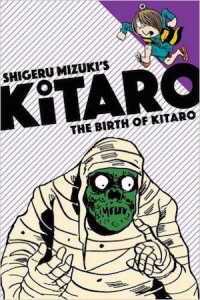
Review: ‘Kitaro: The Birth of Kitaro’
 Kitaro: The Birth of Kitaro
Kitaro: The Birth of Kitaro
Writer/artist: Shigeru Mizuki
Drawn and Quarterly; $12.95
The signature work of the late Shigeru Mizuki, who just passed away last year, was his GeGeGe no Kitaro/Hakaba no Kitaro comic. The series originally ran from 1960 to 1969 and starred Mizuki’s own idiosyncratic reinvention of a once-popular kamishibai/paper theater character. Mizuki’s Kitaro was a little yokai boy with one geta-sandaled foot in the world of supernatural and the other in the world of everyday human beings, who he often fought to defend from his more malicious spirit peers.
In fact, Mizuki’s comic went a long way towards preserving and popularizing late 19th century/early 20th century folk beliefs in yokai, and it’s difficult to imagine large swaths of current Japanese pop culture–from some of Hayao Miyazaki’s most popular films to the recent Yokai Watch franchise–without Mizuki’s work.
ADVERTISEMENT
ADVERTISEMENT
Drawn and Quarterly has been publishing works of all genres from the prolific Mizuki in high volume and at an accelerated rate for five years now, including a 400+-page 2013 Kitaro collection. Now they’re returning to Mizuki’s Kitaro for a new, all-ages friendly series of collections, featuring the very first, stories, never before available in English, all published in the familiar digest/tankobon format we Americans are most familiar encountering manga in.
So who is this Kitaro character? He’s the last surviving member of The Ghost Tribe, a child born to a pair of sick and dying yokai and raised by a human couple until he gets too weird for them. So he strikes out on his own, watched over by Medama-oyaji, an anthropomorphic eyeball that contains the spirit of his father. They are often in the company of Nezumi Otoko, a dirty and rat-faced schemer who is just as often Kitaro’s opponent as his ally.
Known as a friend of humanity, Kitaro fights off malicious yokai or disciplines mischievous ones using his wiles, the folkloric knowledge found in his yokai files, and the bizarre powers he’s inherited, like hair that he can use as a lariat or shoot like darts, a chameleon-like tongue, and so on.
Like many serial comics, these first stories take a bit to start settling into a familiar form. The first story, Kitaro’s origin, barely features the character, but does feature his two sets of parents, and the icky origins of his Medama-oyaji, who drips out of the decomposing skull of his father and inchworms along before growing arms and legs. (That’s Kitaro’s biological father on the cover, by the way.)
The remaining six stories take on an episodic structure of sorts, in which Kitaro encounters a different yokai in each story. These range from giant monsters to creepy ghosts, with a scariness level often in excess of, say, your typical Scooby-Doo monster, and closer to the ogres and cannibal witches of fairy tales, drawn by Mizuki in varying levels of detail, depending on how serious the reader is meant to take the threat. (The giant cow-headed, crab-bodied sea monster that attacks a village is drawn to resemble a creature of classic Japanese art come to life; a face-stealing yokai that catches other ghosts and makes them into tempura is as cartoony as our leads.)
Though similarity sets in, from humans attempting to contact Kitaro via a special mailbox to the last-panel performance of Kitaro’s “Ge Ge Ge” victory song by insects, the variety of the yokai makes each of the stories new and exciting.
This is the first in a series of seven similar collections Drawn and Quarterly has planned, which should provide a new generation of U.S. children the opportunity to embrace Mizuki’s inspired supernatural adventures in the same way that past generations of Japanese kids have.
About J. Caleb Mozzocco
J. Caleb Mozzocco is a way-too-busy freelance writer who has written about comics for online and print venues for a rather long time now. He currently contributes to Comic Book Resources' Robot 6 blog and ComicsAlliance, and maintains his own daily-ish blog at EveryDayIsLikeWednesday.blogspot.com. He lives in northeast Ohio, where he works as a circulation clerk at a public library by day.
ADVERTISEMENT
ADVERTISEMENT
SLJ Blog Network
One Star Review, Guess Who? (#202)
This Q&A is Going Exactly As Planned: A Talk with Tao Nyeu About Her Latest Book
Parsing Religion in Public Schools
Take Five: LGBTQIA+ Middle Grade Novels
ADVERTISEMENT







